May 9th, 2013 §
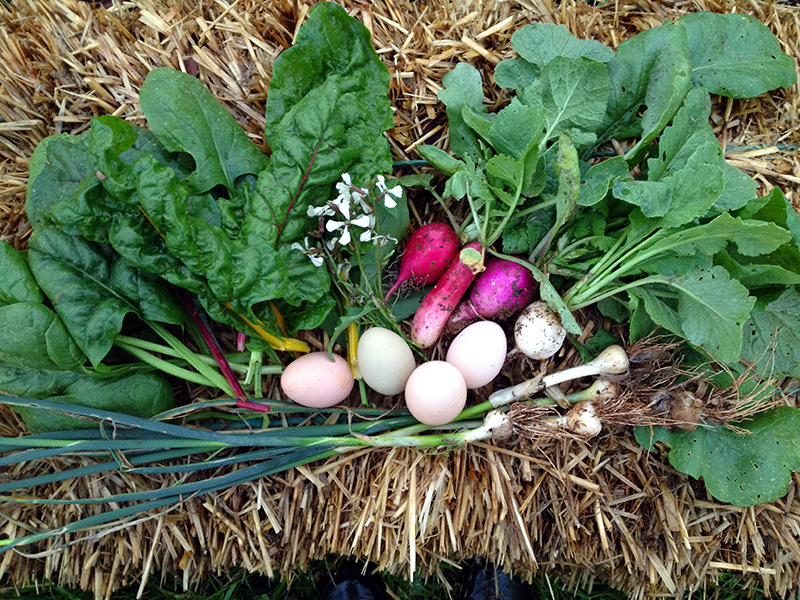
We’re in it now, thank goodness, the season when dinner is picked straight from the garden. Tonight’s salad will be spinach and Swiss chard, both overwintered, and this year’s first radishes along with some wild onions growing around the garden fence. I’ve never eaten wild onions, but they grew tall and lusty while my seeded spring onions failed to thrive, so I sliced them up tonight when I composed my salad. The onions have a very delicious, pungent flavor that I can only describe as “wild lawn-like.” They tastes like the smell of a freshly mown pasture. They may overpower the salad, but I stacked their flavor against a hefty homemade balsamic and dijon dressing and we will see where it goes. The greens were a bit sturdy so they’re all getting happy in the dressing, wilting a bit before I dig in.
And of course, today’s eggs are in there along with some arugula flowers, which are a beautiful, peppery garnish. All together, this would make a slamming fritatta. And not only does this feed me—the radish and onion tops, chard stems and egg shells go straight to the compost, where they feed the worms that enrich the soil that goes back in the garden. A closed system, and a beautiful one.
You may note the slug on the chard leaf. We’ve had two days of rain and the slugs are out in force. You may either eat or discard the slug when you make your own version of this salad!
December 31st, 2012 §
For weeks now there’s been a mystery among the chickens. They’ve been losing feathers across their lower backs, sometimes so much so that they would bleed, attracting the other chickens to peck at their wounds. They’re too young to molt, and I didn’t find any symptoms of mites or lice, so I suspected the newly “active” young cockerel, Calabrese, of clumsy technique.
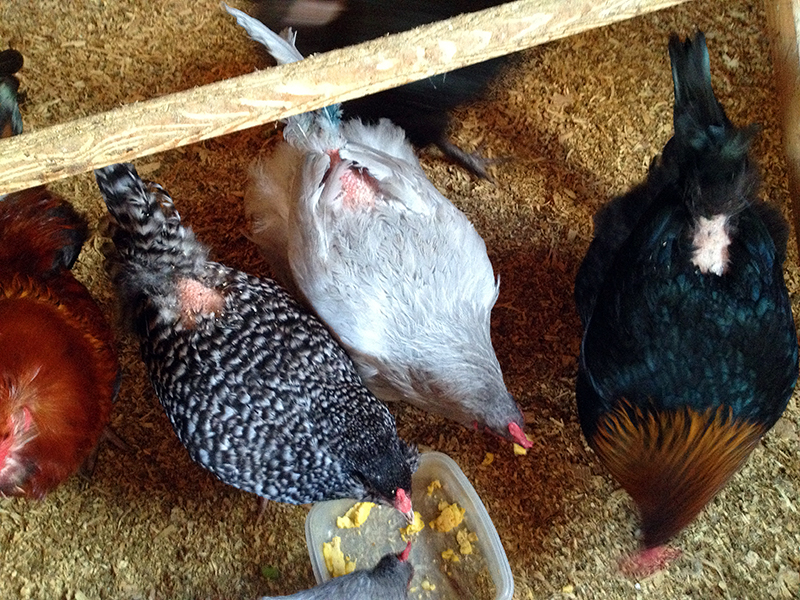
But the other day I noticed that even he was starting to get a ratty back. I picked him up by the feet and dug around in his tail feathers. I found a group of blood feathers (growing feathers with active blood supply still in their sheaths) that had been ripped off close to the skin and were bleeding.
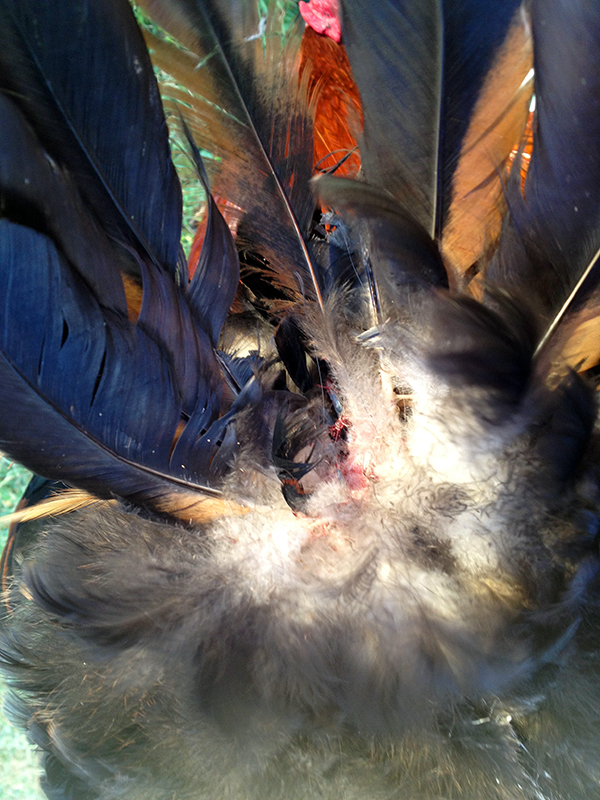
Hmmm…the plot thickens.
I looked at the hens again and saw that only one had pristine feathering on her back: Iris, my broody hen. This surprised me, as Lilac has historically been the feistier hen and I’ve never seen Iris attack any of her coopmates. I was loathe to separate her from the flock because of the upset to their social dynamic, so I looked for other solutions. A quick internet search turned up a lack of protein as a possible reason for feather eating.
As a quick supplement I whizzed eight eggs, shells and all, in my food processor and cooked up a giant omelet.
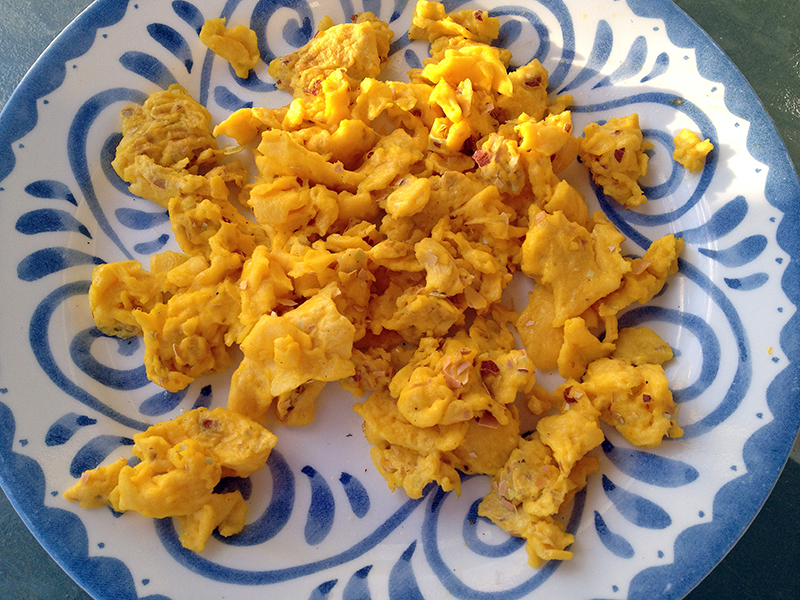
I fed this to the birds as I caught them, one by one, for ministrations. I started with Calabrese, whose broken blood feathers were continuing to ooze and no-doubt attract more pecking from the flock. I pulled each out with my pliers.
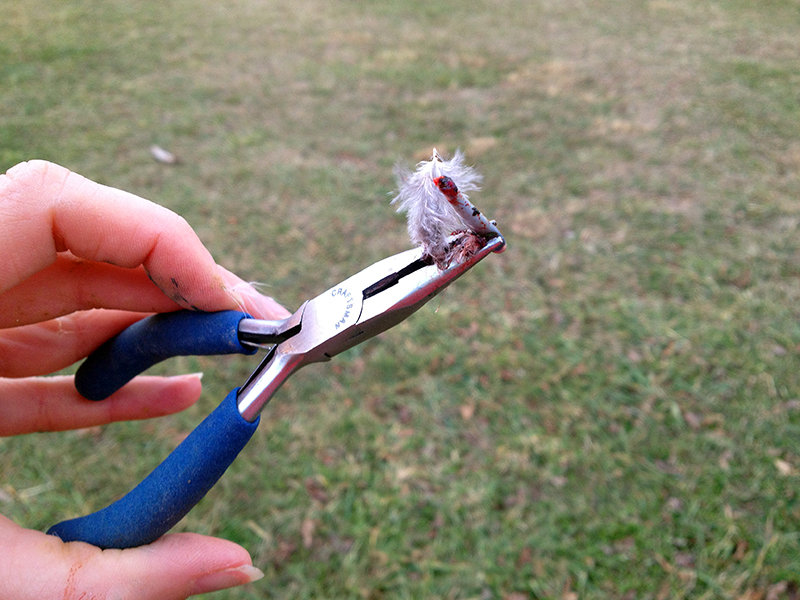
Then I rubbed all the birds with blue food coloring, which tints their red skin and makes it less attractive to picking.

By the time that fiasco was over I had food coloring on my jacket, on the coop, my dog’s nose, and of course on my Smurf hands:
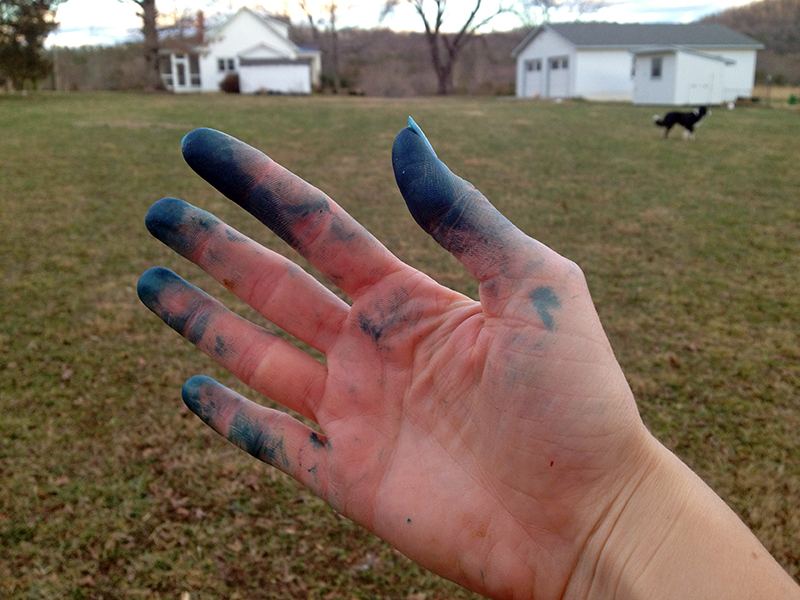
But triage is complete and now I must turn my attention to my flock husbandry, which is obviously lacking. I spent the better part of Saturday reading halfway through Harvey Ussery’s wonderful book, The Small-Scale Poultry Flock. I picked this up at the Mother Earth News Fair and just now have gotten in to it. That I can read it straight through like a novel is testament to Ussery’s writing. I think he gives the best advice on chickens that I have read anywhere—really practical stuff presented in a humorous, engaging tone. I appreciate Ussery’s wholistic outlook on keeping birds and his emotional sensitivity to creatures that are often regarded with the opposite of respect.
My reading confirmed what I already knew, that my birds were too closely confined, and bored. I let them out to range the yard and gardens about twice a week, but that’s obviously not enough to keep them happy. So now, in addition to feeding supplemental protein, I need to figure out a way to get the birds outside more often while still keeping them safe from hawks, foxes, dogs, etc. And, I need to take more advantage of the chickens’ manure and their pest-eating skills. And it wouldn’t hurt, what with the cost of feed, to have them hunt some of their own food.
I’ve got a nice compost pile just sitting in the woods, far enough from the coop that the birds don’t venture there.

And I’ve got a deer-fenced garden enclosure, reinforced with dug-in wire at the bottom, that’s now got nothing but a thick straw mulch on it to keep the soil organisms happy through the winter.
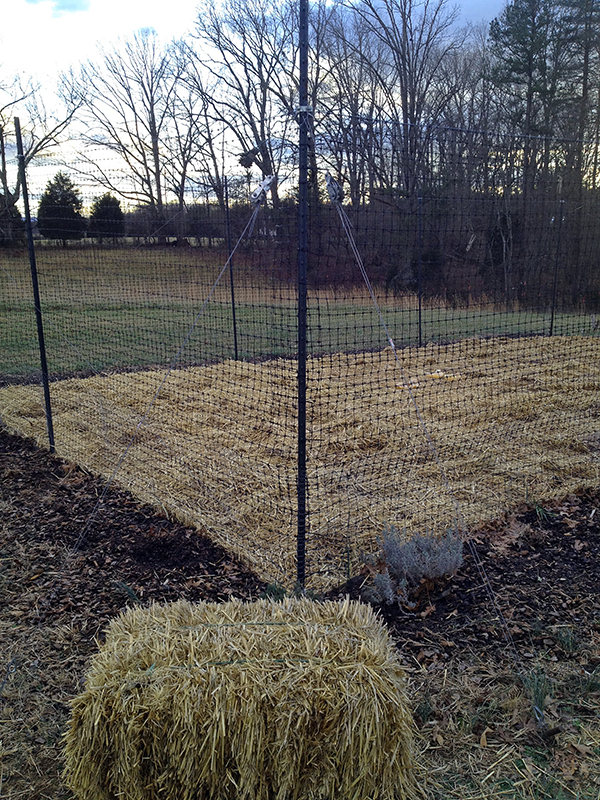
I wonder what would happen if I started composting directly in the garden, turning the chickens out in there each day to pick through the pile? The worm life would definitely benefit. The birds would be reasonably protected from ground predators, and if Tucker is outside he helps chase off any threats from the air. I just need to rig a semipermanent passageway from the coop to the garden so that the birds can travel back and forth, both for safety and egg laying, which happens throughout the day.
I’ll still let the chickens out to roam the pasture if I am around to supervise, but this might be a good way to solve the confinement problem I am having while putting the birds to work in the garden. It’s worth a shot.
And then when I do some more research and get some cash flow I will invest in an ElectroNet fence. With that I could have the birds work different sections of the yard without always worrying that they’ll be carried off by a fox. I think it would be good to erect the fence around the garden and run the birds in this “moat” after the garden has been planted and they can no longer be free in it. Perhaps they would help with the insect population if they were serving as ravenous alligators to any bug trying to crawl toward my vegetables!
December 10th, 2012 §
Have been a whirlwind of productivity and enjoyment best relayed in photographs.

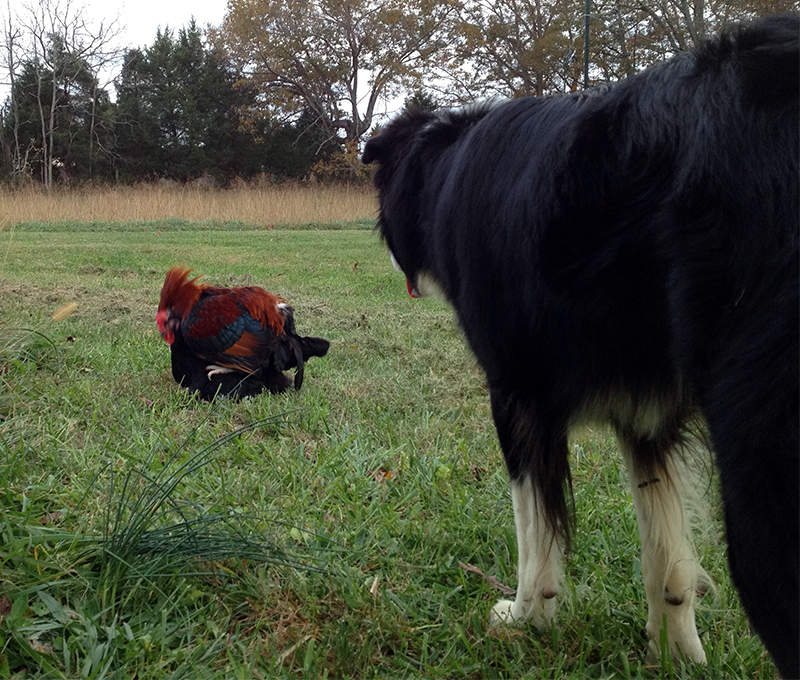 Pervy Tuck
Pervy Tuck
 First raid of the compost pile several years in the making.
First raid of the compost pile several years in the making.
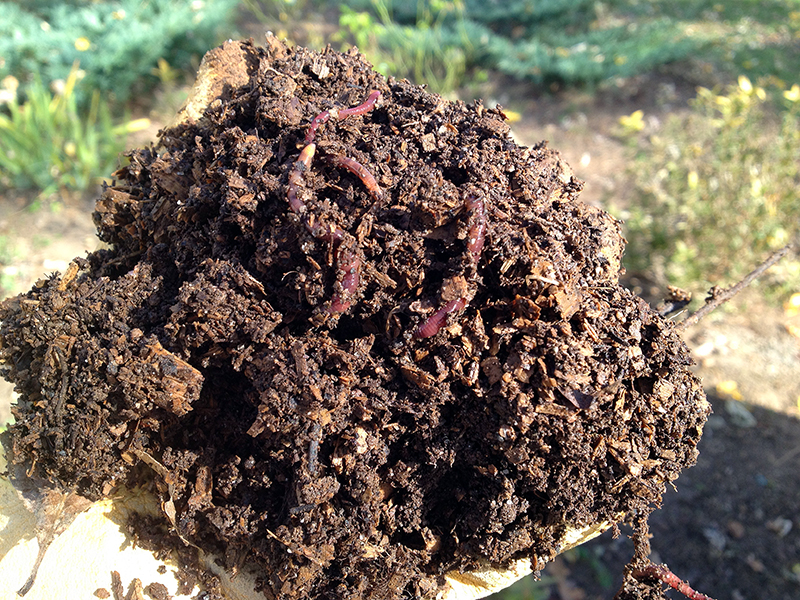 I know I am an unusual girl to take such pleasure in this handful of homemade worm-happy, vital compost. It is beautiful, and I am proud.
I know I am an unusual girl to take such pleasure in this handful of homemade worm-happy, vital compost. It is beautiful, and I am proud.
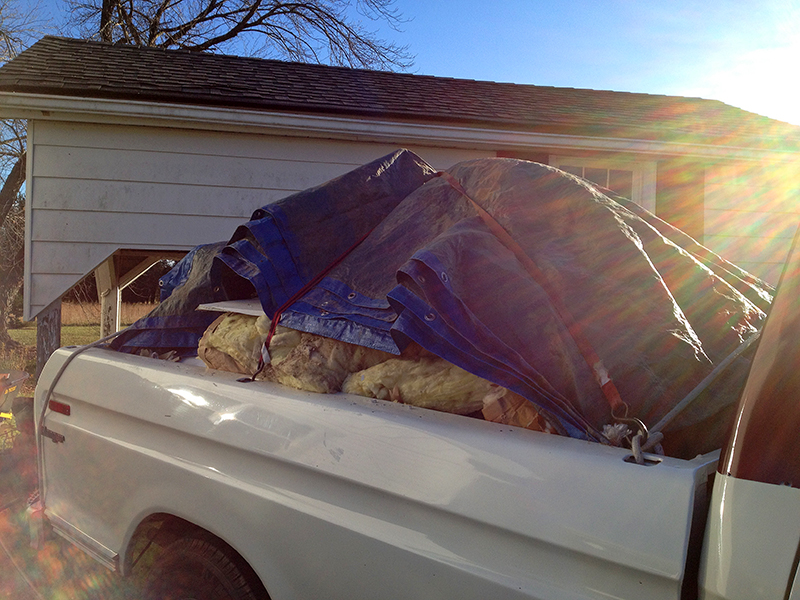 Well house renovation begins with an insulation/drywall blitzkrieg.
Well house renovation begins with an insulation/drywall blitzkrieg.
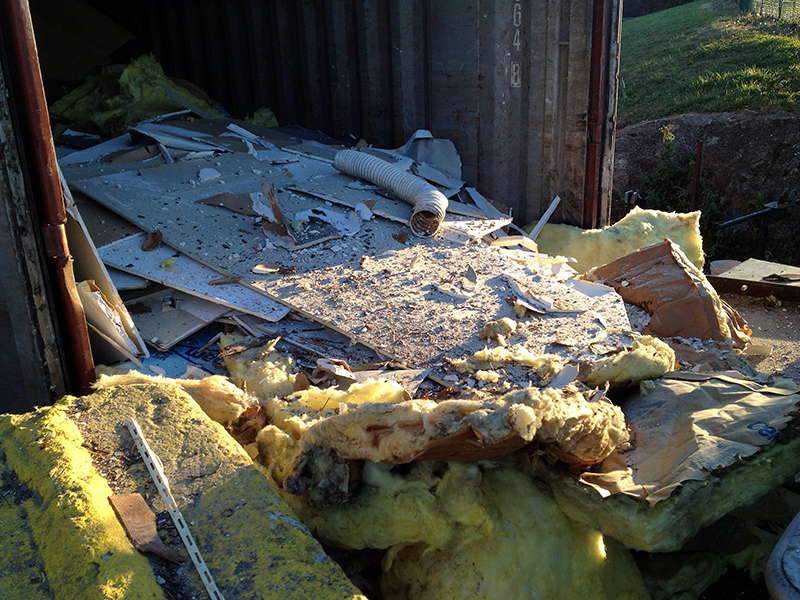 And a right-under-the-4:00 p.m.-closing-wire Saturday dump run. Good riddance to this stink bug, ladybug, mouse poo pile!
And a right-under-the-4:00 p.m.-closing-wire Saturday dump run. Good riddance to this stink bug, ladybug, mouse poo pile!
 Lots of wonderful meals prepared, including salmon and sweet potato stew, goat cheese and caramelized onion focaccia, and a roasted beet salad with balsamic dressing. The eating’s been good around here lately!
Lots of wonderful meals prepared, including salmon and sweet potato stew, goat cheese and caramelized onion focaccia, and a roasted beet salad with balsamic dressing. The eating’s been good around here lately!
 Vintage gas pumps resurrected from my woods and hauled away to be transformed in to art.
Vintage gas pumps resurrected from my woods and hauled away to be transformed in to art.
 Thanksgiving mushroom walk!
Thanksgiving mushroom walk!
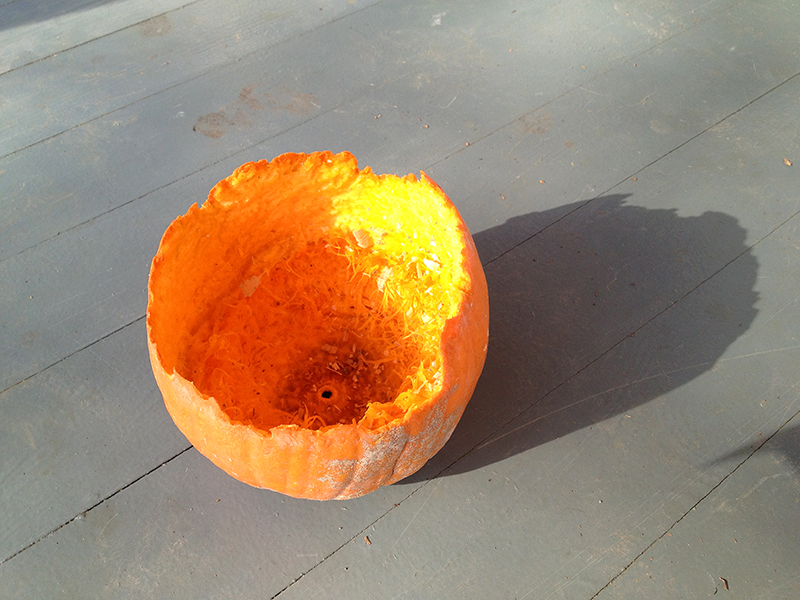 Chicken sculpture
Chicken sculpture
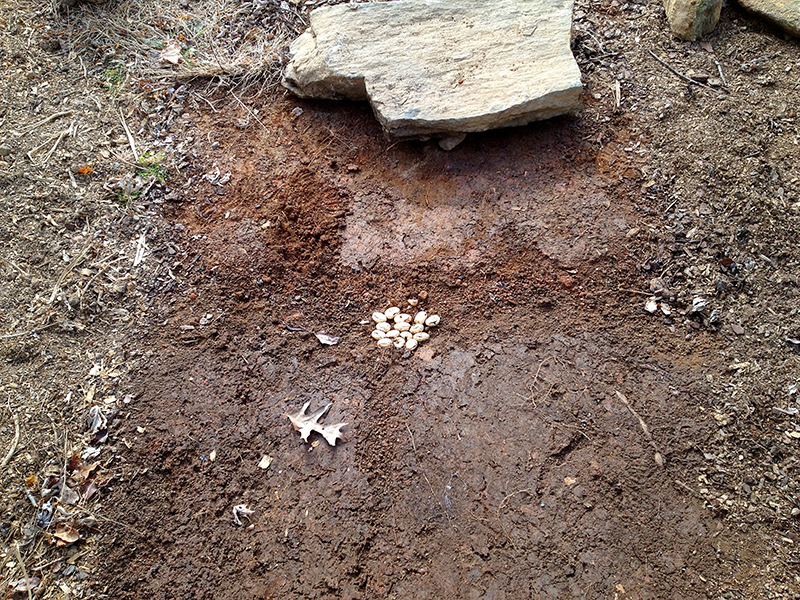 Discovered under my OSB front sidewalk: a whole clutch of snake eggs!
Discovered under my OSB front sidewalk: a whole clutch of snake eggs!
 I am still cringing that Mama Snake (probably Mama Black Snake) managed to sneak her brood so close to the house. And yet I saw not a single black snake last year, when they were incubating right on my doorstep! That’s irony for you.
I am still cringing that Mama Snake (probably Mama Black Snake) managed to sneak her brood so close to the house. And yet I saw not a single black snake last year, when they were incubating right on my doorstep! That’s irony for you.
 Thrifty new front walk under construction, using stones dug from the property. It’s rustic, but it’s better than rotting, snake-incubating OSB and sure beats the $9,000-$18,000 quotes I got from the pros for hardscaping this area…
Thrifty new front walk under construction, using stones dug from the property. It’s rustic, but it’s better than rotting, snake-incubating OSB and sure beats the $9,000-$18,000 quotes I got from the pros for hardscaping this area…

And finally, lots of woodstove sitting, reading, and spending time with this handsome lad, who is relishing his increased responsibility on the farm and every day grows more accomplished. Official presented kill tally: two wood rats and one mole. Way to go, Farmdog!
October 25th, 2012 §
I left Hill Farmstead in the late afternoon via Routes 15 and 2. I stopped for gas around sunset in St. Johnsbury, Vermont, and started calling around for a place to stay, searching for pet friendly hotels on my iPhone. This technique had worked pretty well all trip, but in St. Johnsbury I had my first challenge finding a dog-friendly room for the night. But after about 45 minutes of searching and a few calls, I lucked on to the Top Notch Inn, in Gorham, New Hampshire, where Hannah sweetly answered my call.
I set off along Route 2, and one of my regrets of this trip is I hadn’t left enough daylight for this very scenic drive through the White Mountains—the queue at Hill Farmstead and the phone marathon in St. Johnsbury had killed my sunlit hours. Even in the fading light I could tell I was surrounded by spectacular scenery, but this was about the extent of my view: the New Hampshire state line sign. At least I bagged another state!
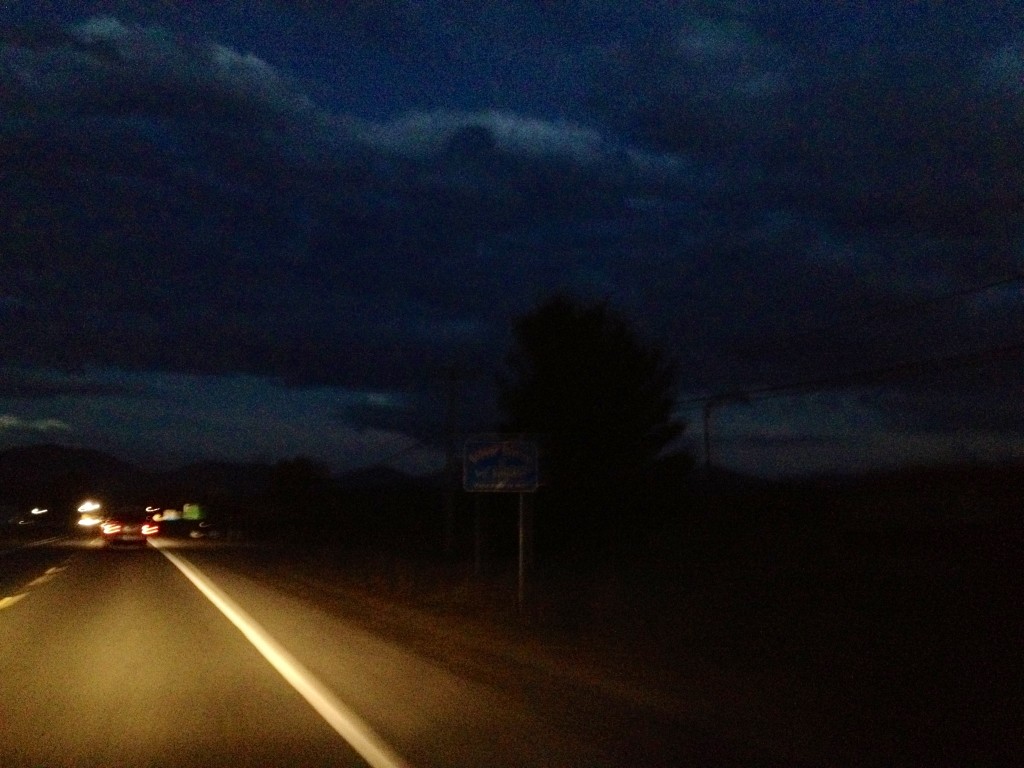
I pulled in to Gorham grateful to have not hit a moose. I received a warm welcome at Top Notch and after feeding Tucker his dinner, I headed out for mine. The Saalt Pub looked promising, so I swung open their door and took a seat next to a few other couples at the bar.

Immediately owner Steve Jackson, above in the checkered shirt, made me feel at home as he poured a pint of the local brown ale on tap, from Moat Mountain in North Conway, New Hampshire. As I drank I struck up a conversation with the woman next to me, the beautiful Jan, who was eating dinner with her husband David. We talked all through dinner, and Jan—a local who’d lived many places and returned home to Gorham—made me feel welcome. When I told her of my trip, she said, “Wow, you’re really brave.”
This struck me, and it’s been a concept I’ve been turning over in my mind ever since as I’ve journeyed as a single woman with her dog. Never once in coming on this trip has bravery entered my equation, and I’ve entered dodgy Route 81 rest stops with pepper spray in hand, walked in to myriad dark hotel rooms, driven more than a thousand miles in a car that theoretically could have a problem at any time, and hiked by myself to the top of granite mountains where with one misstep I would plummet to the ocean below.
And yet I don’t consider any of these things to be brave. They are just me, living my life. I decided a long time ago that I would rather seek experience than be afraid, and I have made peace with the idea that my number could be up at any moment. I do what I can to be smart, aware, and safe, but beyond that a certain kind of fatalism takes over and I find that awfully freeing.
But back to the trip at hand, where David has just set my dinner before me. A plate of sausage, roasted red peppers and onions, pesto, tapenade, goat cheese and bread—with one beautifully fried lacinato kale leaf. It ended up being my favorite meal of the trip—a combination of all my favorite things done perfectly by David’s wife, the chef Liz Jackson.

Between bites I chatted with Jan and I gave her a few pointers about how to use her new iPhone. After a second beer, I rolled back to the Top Notch feeling nourished and happy. Everyone I’d met in Gorham seemed like good people, and I’d enjoyed wonderful food and drink prepared with attention and care. Not too bad for a last-minute gas station google search. That’s road trip serendipity.
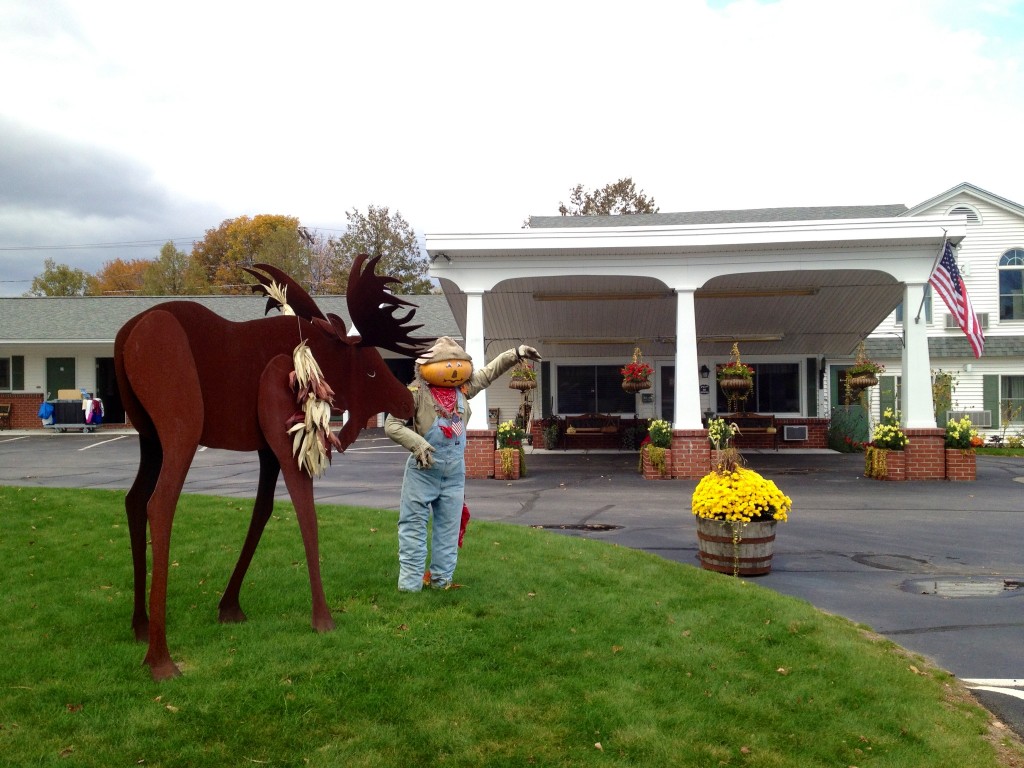
In the morning I checked out of the hotel, but not before Tucker got in a few good barks at the lawn decor, which proved to be pretty much a conglomeration of his nightmares. All through this trip Tucker, when in the car, has barked at big outdoor sculptures and scarecrows. With six days until Halloween, and by passing through the land of moose monuments and chainsaw art, this has meant a pretty predictable stream of commentary from the back seat. It’s interesting to me that the exact same items don’t seem to bother Tuck when he’s outside of the car—we walked right around this moose and scarecrow duo with no fuss—but in the car it’s so predictable that I brace for it.
I grabbed a sandwich and large tea for the road from the White Mountain Cafe and Bookstore, and then hit the highway to finally check off a big prize on my quest to visit all 50 states: Maine!
October 24th, 2012 §
I left the Topnotch Resort in Stowe and drove in to town for breakfast. I picked up a bag of Tucker’s hard-to-find hippie natural dog food at a great little store, the Dog and Cat, and then continued to the Green Goddess for breakfast. A grilled tofu wrap and freshly squeezed carrot/beet/kale/ginger juice in hand, I headed toward the Quiet Path, where the Topnotch concierge had recommended I take Tucker.
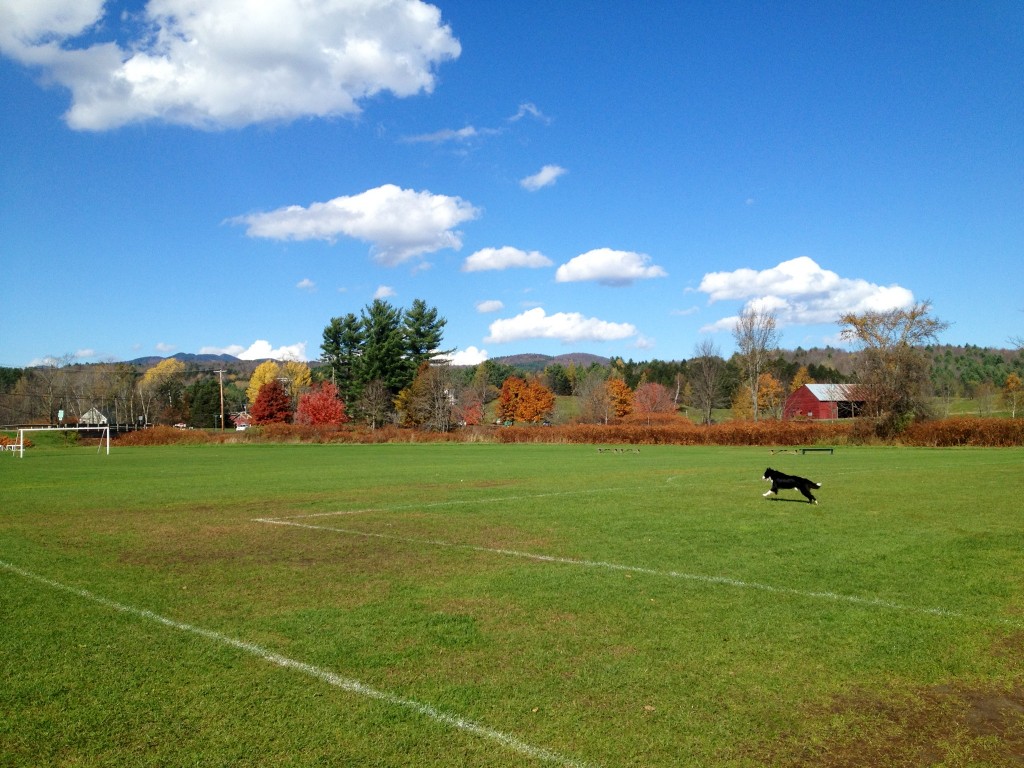
We found a great open field where Tuck enjoyed a few rounds of fetch before joining in play with a couple of local dogs. Then we pressed on to the West Branch River, where my dog got his fill of fresh spring Vermont water.
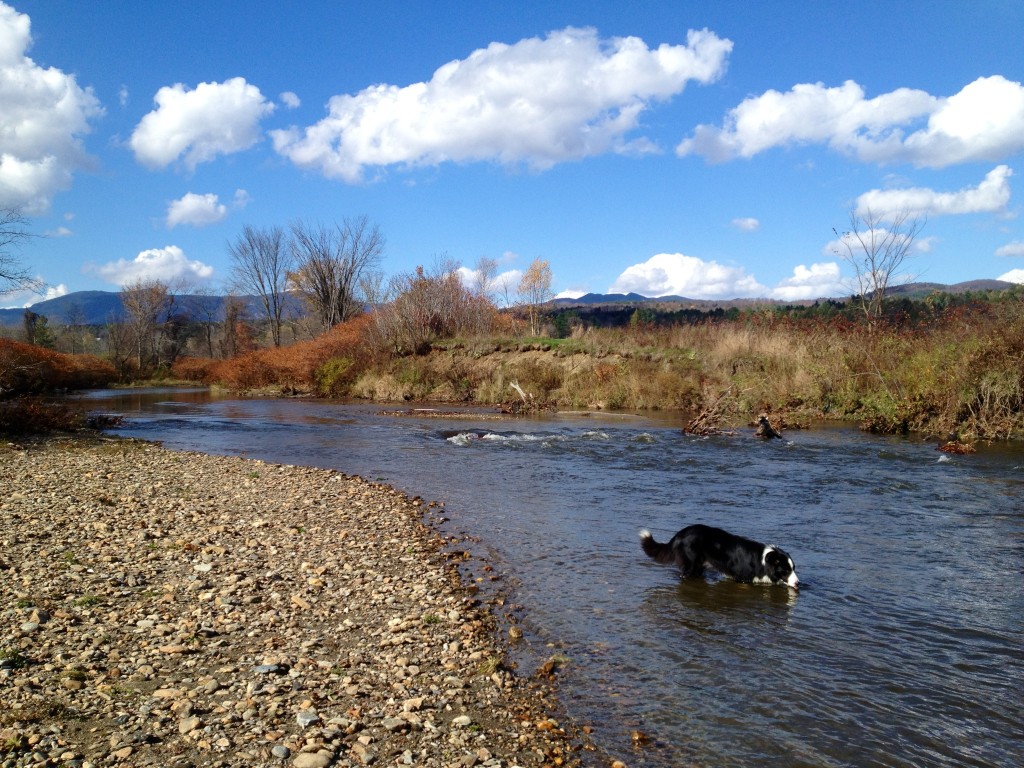
From Stowe, I began to head east toward Maine on Route 100. I had to pull off, however, when I passed the Rock Art Brewery. Here I had the friendliest tasting of my Vermont brewery tour, and I really enjoyed their Jasmine Pale Ale.
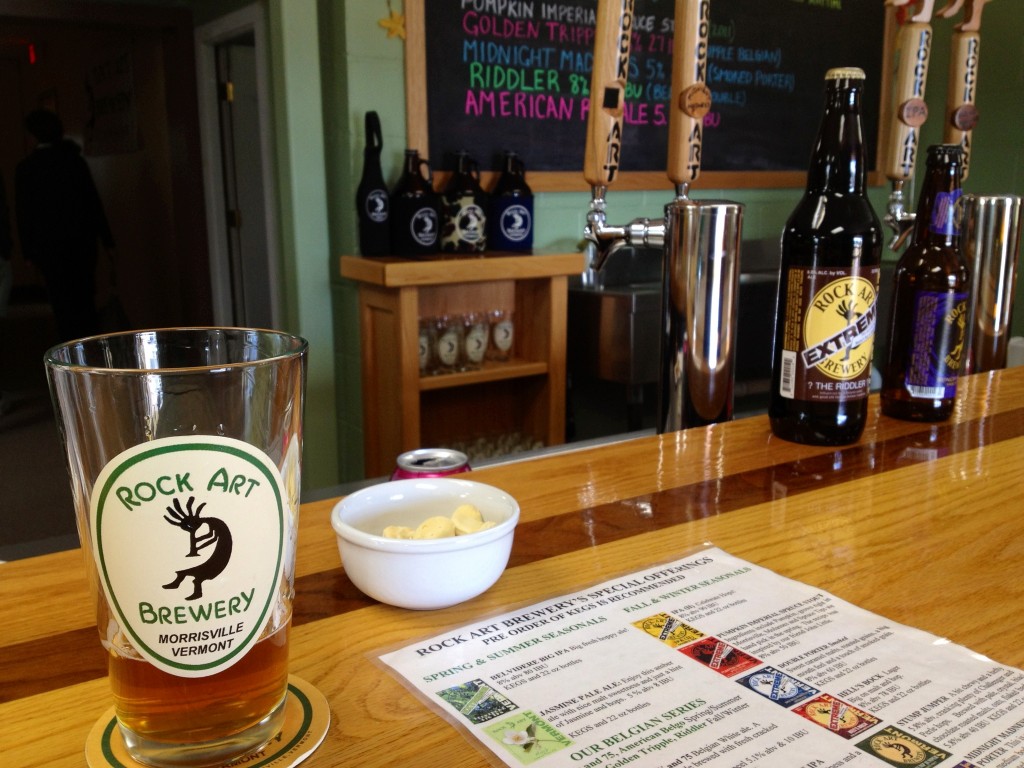
But I had my eyes on a bigger prize, one to be found way off in rural Greensboro, Vermont up a rutted gravel road in an area that looked so desolate I was sure I was lost: Hill Farmstead Brewery, home of what some consider to be the best craft beer now being made in the United States. Once again, thanks to Brad for the hot tip! I knew not of the brewery before I arrived, which I believe led to less tasting bias than more knowledgeable beer freaks may possess.
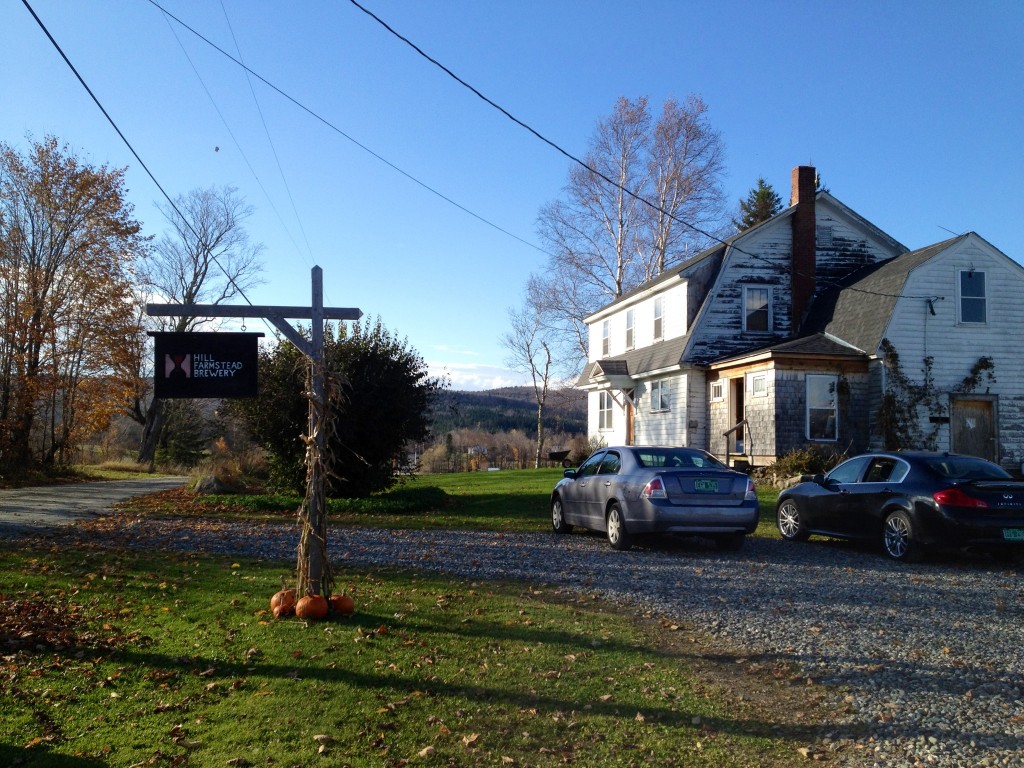
Any Google search will fill you in on the Hill Farmstead backstory, so here’s my experience. The brewery is basically a converted garage attached to a ramshackle homestead on the top of a hill surrounded by wild Vermont mountains. When I arrived, the parking lot was full and people were queued four or five deep at the taps set up in the corner of the garage. All were there for tastings or growler refills or a glimpse of Shaun E. Hill, American craft brew wunderkind, as he washed glasses and worked the taps. Some of the stories I’ve read have even gone so far as to dub Shaun the best brewer on the planet. High praise for a brewer in his early thirties, but would the beer live up to the hype?
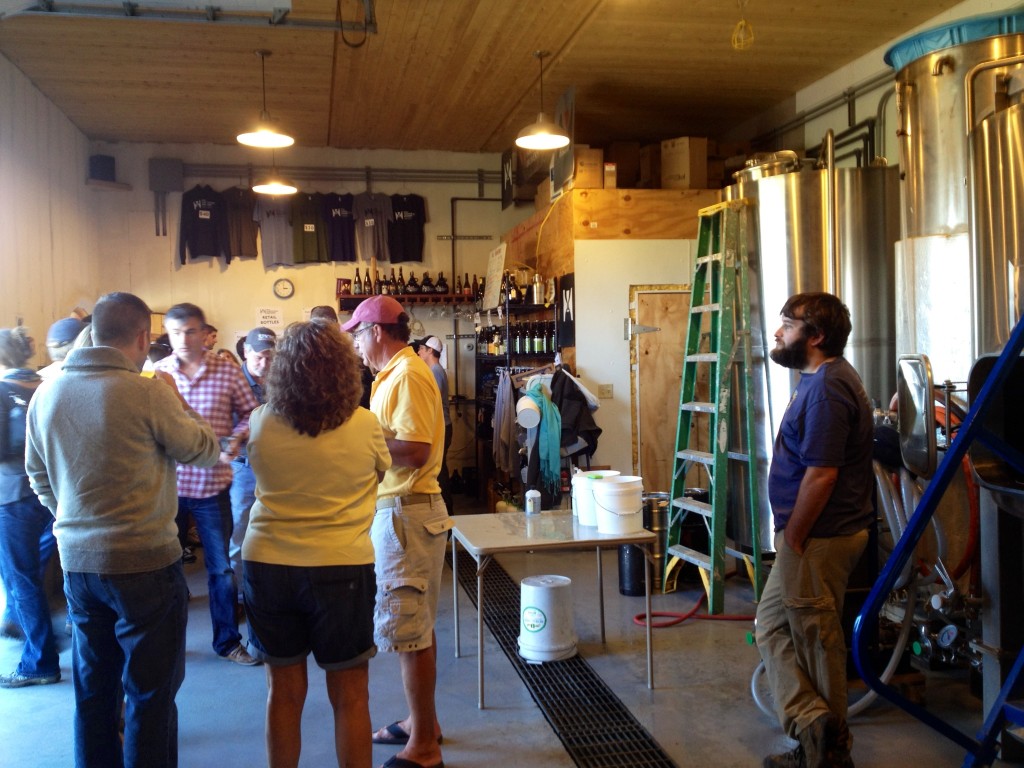
I had four samples of the six on tap, and couldn’t find fault. The two that I liked best were Abner, the double IPA, and Holger Danske, a smoked brown ale. Hill Farmstead has neither of these beers in bottles, and very, very limited distribution outside of Vermont for a few of their other offerings, so the best and often only way to enjoy these beers is from the source.
Abner and Holger Danske were two of the best beers I’ve ever had, and exhibited taste profiles that were complex and changing yet perfectly smooth, with a range of flavors that were beautifully balanced. I won’t go into more beer geek descriptions, which are widely available online if you’re interested. However, I encourage you to head up that hill and taste for yourself. You won’t regret the trip, but be forewarned that once you taste Hill Farmstead’s offerings you may be left with a craving that’s hard to fill with whatever you’ve got available in your local supermarket. I know I’m ruined.
It was with a sadness that I pointed my car toward New Hampshire, assuaged only by a couple of 750 ml. growlers of Abner and Holger Danske keeping company with the Heady Topper in my cooler. As the Hill Farmstead beers were fresh and not bottled, I knew I had just a couple of days to enjoy them—an event to which I looked forward even as I mourned finding beers so delicious and yet so unattainable once I returned to my life in Virginia.
October 20th, 2012 §
Thursday morning I picked up a goat cheese and watercress sandwich from the Otter Creek Bakery in downtown Middlebury, Vermont. I ate half of it while wandering the small downtown area, which included a neat bookstore, the independent-since-1949 Vermont Book Shop, as well as an establishment smelling heavily of patchouli and alpaca sweaters.
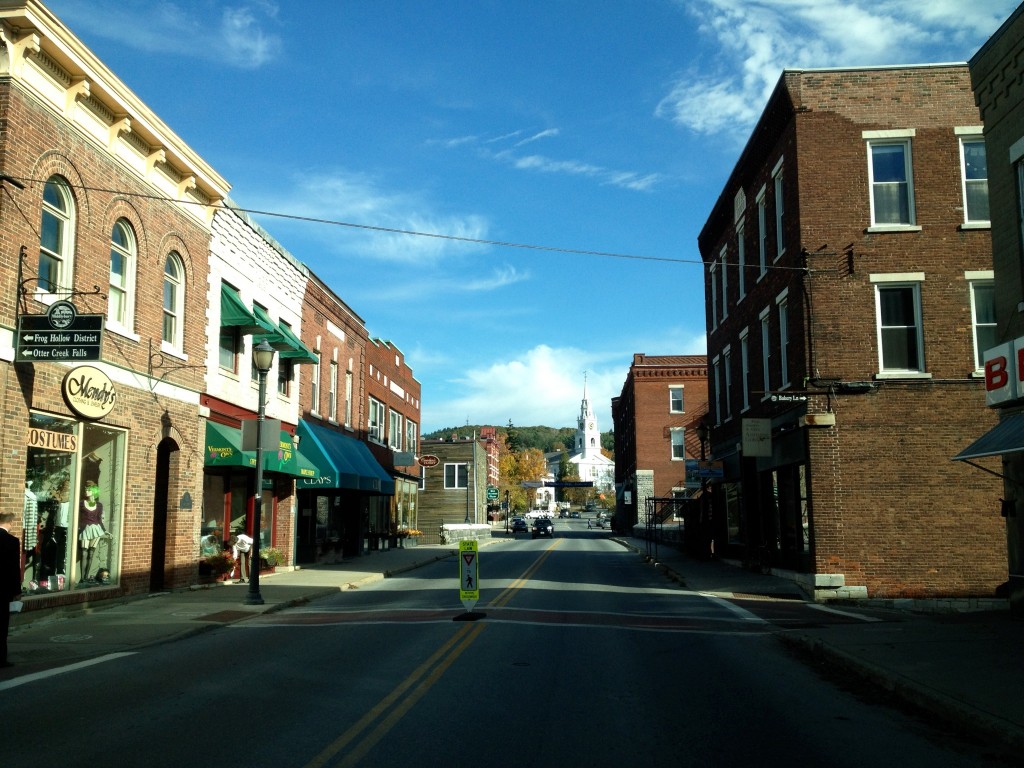
I was in a great store featuring Vermont artists when I heard a loud roar outside. I thought it was some sort of mechanical equipment, but when I stepped on to the screened back porch I realized that the shop was actually cantilevered over a waterfall in the Middlebury River.
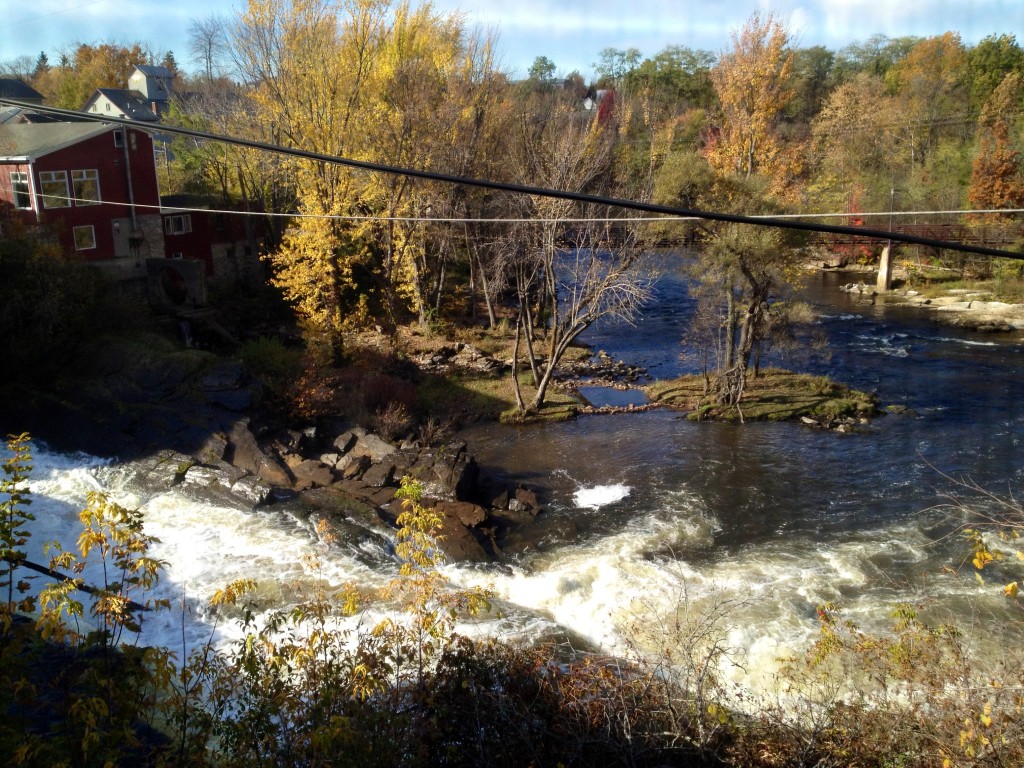
After my downtown wandering, I drove to the Middlebury College Museum of Art. I got Tucker out for a quick walk on the grounds and it didn’t take me too long to realize we’d stumbled in to the middle of a high school photography class field trip. Tuck posed by a pond for several budding artists and it gave me a kick to think his picture may be hanging on the wall for next week’s critique. Been there, done that!

The art museum, which has free admission, was showing a lovely little exhibit of original photos published in Alfred Steiglitz’s Camera Work. Camera Work, a magazine begun in 1903, was the most influential publication to elevate photography into the realm of fine art. To see images by Steiglitz, Paul Strand, Edward Steichen, and more felt like being among old friends, and it reminded me of how much I enjoy photography and how little of myself, over the past few years, I have devoted to something that used to be central to my identity. Perhaps this is a wake-up call.
From Middlebury I headed north out of town, still on Route 7. I hadn’t gotten very far until I came across Otter Creek Brewing. It was about eleven in the morning—certainly time for the first tasting flight of the day!
I sampled a range of offerings, from the lightest ales to the darkest stouts, and I have to admit that none really stood out to me as remarkable…which is pretty much the conclusion I’ve come to buying their beers off the shelf in Virginia. Some of the Wolaver’s Organic beers made their way in to my flight, and I found them particularly lacking. Who knew pesticides make the beer tasted good?! Nonetheless, it was a great start to my brewery tour of Vermont, and drinking at eleven in Vermont sure beats sitting at work logging in to the day’s flash sale Web sites!
I finished my breakfast sandwich while walking Tucker in the field behind the brewery, where he snuffled out some ground-dwelling creatures in the duff, and then we hit the road toward our next destination, the Shelburne Museum.
October 18th, 2012 §
At our first stop to stay with a friend in Lake Waramaug, Connecticut, Tuck is the hit of the Hopkins Vineyard wine festival.

He had more people come up to greet him than ever in his life, and he did a great job as an English Shepherd breed ambassador.

Beautiful Lake Waramaug, where some of the boathouses are the size of my house.
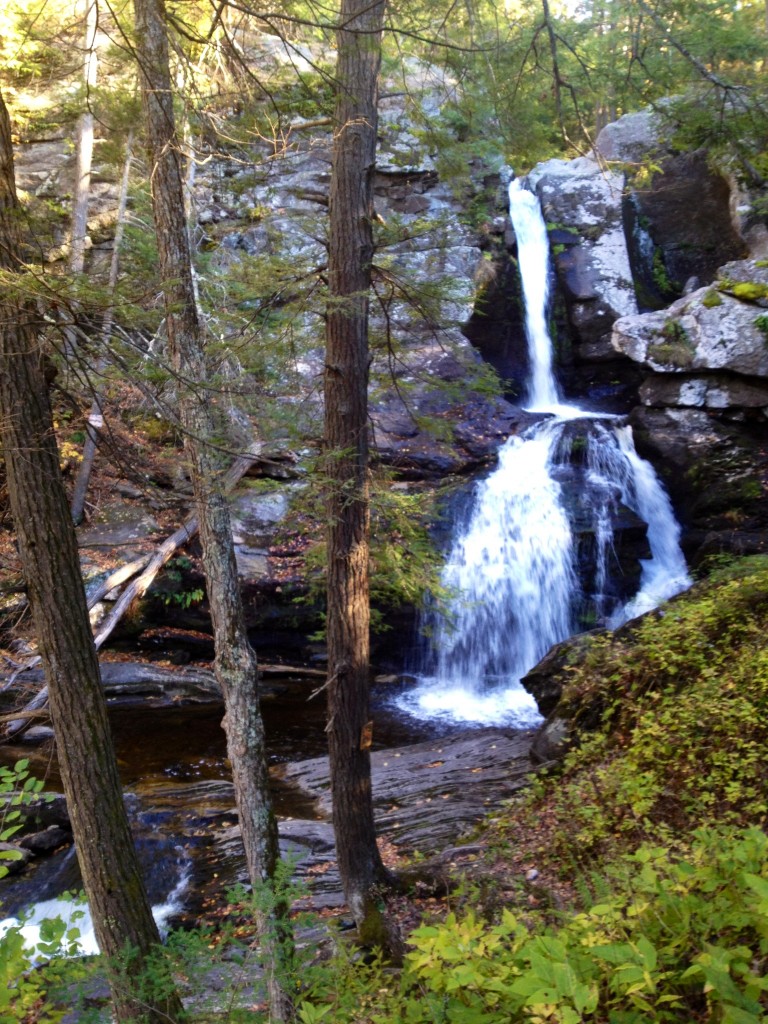
Dog hike at Kent Falls.

The Litchfield Hills of Connecticut are about as picturesque as you can get for a developed area. It was like the whole place was made for this time of year—even pumpkins and corn stalks look chic on the porches of classic New England homes. I imagine Halloween night or Christmas in some of these little towns, such as Kent, would provide enough seasonal cuteness that even the antichildren among us could be swayed.
Many of these properties are weekend homes for the New York City crowd…which explains why they are so well manicured and pristine. The army of contractors servicing the homes doesn’t hurt either. In one morning gardeners, generator service men, tree trimmers, and lawn mowers descended on the home next to my friend’s in a home maintenance frenzy.
I had some great food during my stay. Three trips to The White Horse Country Pub, whose branding extends even to the puff pastry horse on top of their pot pie, a few to Marty’s cafe (the classiest internet cafe I’ve ever seen), and brunch at G.W. Tavern were all delicious and had great decor. In the ladies room at G.W., someone had painted viney trees all over the William Morris wallpaper, to great effect.
Thanks to JPH and Dexter for hosting in their darling cottage and beautiful neighborhood. You’ve done it again with finding an awesome place to live!
October 17th, 2012 §
The Bonafide Farmer and her farm dog are on the move! Tucker and I are road tripping through New England. We spent the last few days in Connecticut and are now in Vermont, a state that I as of today get to check off my visited list—a lifelong dream come true. More to come as I figure out Wordpress’ mobile app…

Frosty morning hike in the beautiful Delaware Water Gap in the Pocono Mountains.
September 27th, 2012 §
I didn’t think many people would want to start their day watching eight live chickens be “harvested” and processed, but the conference room for the 10:00 a.m. “Pluck A Lotta Chickens” live demonstration was standing room only way before the presentation began. There must have been 500 or more people there to learn how to slaughter and butcher chickens.
David Schafer, the very easy-on-the-eyes creator of the Featherman line of poultry processing equipment, and Joel Salatin, our previously mentioned hero of the grass farming movement, stood at the front of the room and introduced us to the morning’s teachers: four Cornish crosses and four Freedom Rangers that had been lovingly reared by a nearby farmer, in the green shirt below, and his family. The birds were big and glossy and gorgeous, a far cry from the half-dead creatures I saw yesterday on the road.
After David and Joel took a moment to acknowledge the birds for their lives and their caretaker for his work raising them, David placed the birds one-by-one, head down, in a wheel of metal cones. He gently extended their heads and carefully sliced the artery right under their jawbones. The blood dropped out of the birds in a gush as they calmly blinked a few times, losing blood pressure.
In a minute or so rigor mortis set in and the birds, which were no longer conscious, flapped wildly in their cones. David let the birds continue to bleed out for a few minutes more before putting them in a rotating scalder.
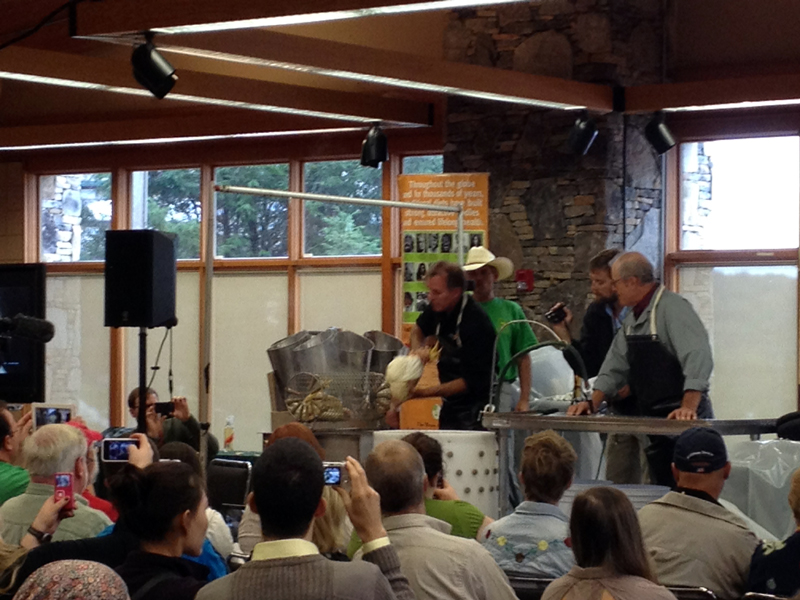
From there he put the birds in a feather plucking machine that bobbled them around until their feathers were rubbed off by rubber fingers. Then Joel took over with the butchering.
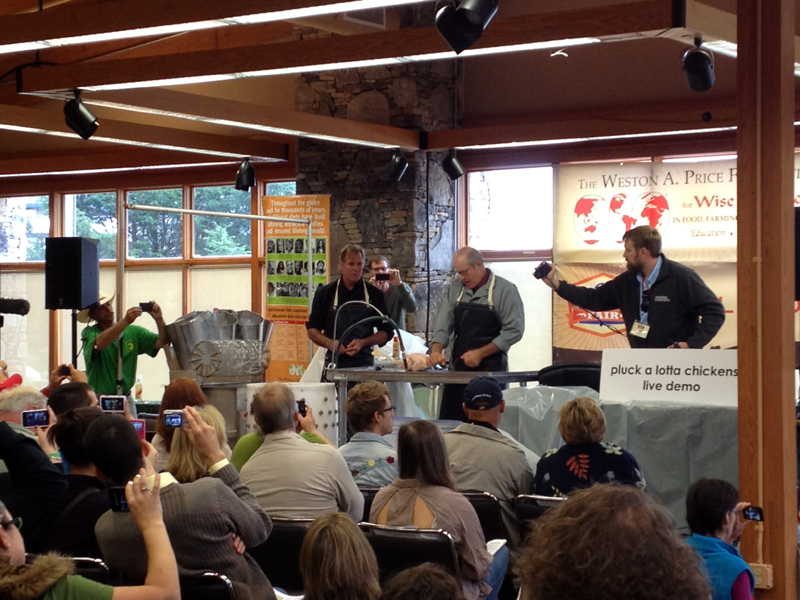
First, he pulled the head off the bird, above, a movement that surprised me by its ease. It was a bit shocking to me how easily the head came away from the body, especially after having worked so hard to keep a head attached to one of my own birds. Then Joel cut off the feet and the oil gland above the tail.
He then made a small incision in the front of the bird to access the windpipe and crop, which he loosened by scooping his fingers under it—taking a moment to remind us to fast our birds for a day before slaughter to make this process cleaner. Then he made another incision at the back of the bird around the vent and was able to pull all the viscera out with one hand. A quick tuck of the legs into a slit in the chicken’s skin and it was ready for an ice-water bath. Joel told us that when racing, he could process a chicken in 20 seconds. Wow.
The best part of the demo was how easy it looked. I’d always been a bit intimidated at the thought of butchering a chicken, anticipating a horrible bloody mess and suffering creature, but after watching these teachers—who are the most famous in the business—I think I could do it. Who knows, maybe next year will find me raising a bunch of Freedom Rangers for my freezer!
After this session I wandered over to Christy Hemenway’s talk about keeping bees in top bar hives, which look like a child’s coffin on legs. Christy runs Gold Star Honeybees in Maine and wrote “The Thinking Beekeeper.” I’ve been dancing around the idea of keeping bees for a couple of years, and have even joined the Central Virginia Beekeeping Association. But after a few meetings and a workshop I started to think that the odds are stacked against the beekeeper. Between big predators, such as bears, and tiny marauders, such as the varoa mite, I had grown disheartened even before setting up a hive and decided beekeeping was a fool’s game.
Top bar beekeeping, though, just might change my mind. In a top bar hive, bees build their own wax combs suspended from narrow wooden bars instead of colonizing premade wax foundations, which are often made from beeswax that’s been treated with pesticides to kill varoa mites. Not exactly something you’d want to eat. And when bees build their own combs, they actually build cells of a size that can’t accommodate the varoa mite. It’s a bit more of a production to extract honey from combs built in top bar hives, but the health of the bees in such a system would more than make up for the inconvenience.
After the bee talk I got some lunch. Strangely enough I went for the chicken kabobs…and noticed while in line that my choice of outfit was well-aligned with other festival goers.
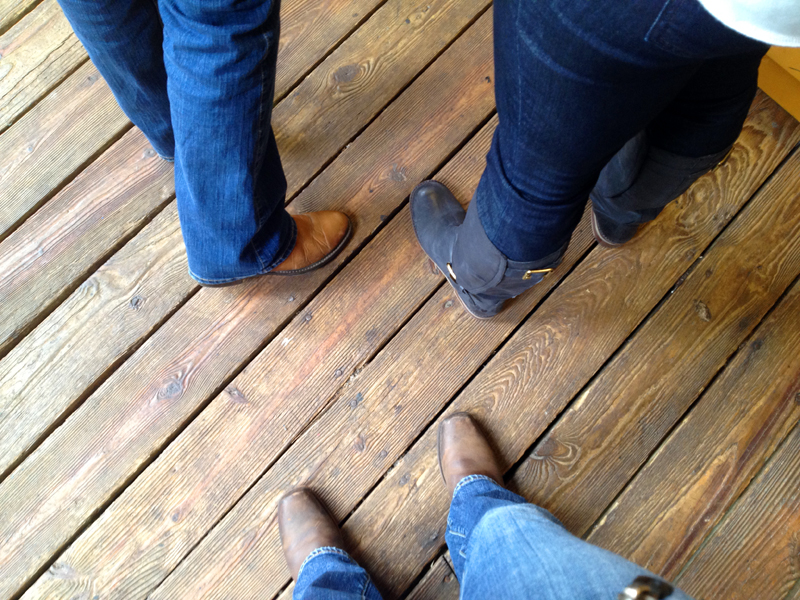
Then on to hear Patricia Foreman talk about gardening with chickens. I’d seen Patricia speak the weekend before at the Heritage Harvest Festival, and her talk was pretty similar to what I’d heard there. She advocates putting our chickens to work creating compost. As the cost of feed is increasing, and my flock size grew this summer, I was all ears. The idea I took away from this talk was that I’d like to turn my chickens out into my garden once everything freezes. I hope that they will till up the dirt and in addition to fertilizing eat all the insect eggs that are plaguing my gardening life. I’d also like to figure out how to build a chicken tractor that can detach from my coop and be moved around the yard, instead of building a permanent run.
Next up was a talk by Jenna Woginrich, of Cold Antler Farm, about how she makes her living blogging and writing. Jenna is an enthusiastic and natural speaker who kept her audience laughing. As I suspected I would be, I was even more inspired by her in person than I’ve been from years of reading her blog. Jenna boiled her success down to a combination of flexibility and stubbornness—necessary traits, she claims, for the self-employed. I admire Jenna for bucking convention and being one to say no thanks to a society that trains us to, “be scared to do what we want to do.” And we don’t need to have all the answers before we start something new—the important thing is to just begin. As she says, “You can drive to L.A. in the dark. Your headlights will get you there 200 feet at a time.”
I stuck around in the same meeting room for the next talk by Wisconsin farmer Ann Larkin Hansen. I’d heard her speak for a few minutes the day before on woodlot management, but her next presentation was on making hay. I wanted to figure out when was the best time to cut hay for optimum nutritional content, and Ann told us the legumes are the key to when to cut. You should make hay when the legumes have grown as tall as they are going to get and are starting to bud and the grasses are just starting to develop their heads. As crops grow taller, beyond this point, the quantity of your hay increases but its nutritional quality decreases. Leave 2-3″ of stubble in the field when you cut to help prop the hay off the ground, which makes it dry faster. Dry hay is key. Wet hay, if baled, can compost and selfcombust and burn down your barn. Not cool. Ann then got into haying machinery and I slipped out to meet Jenna at her booksigning.
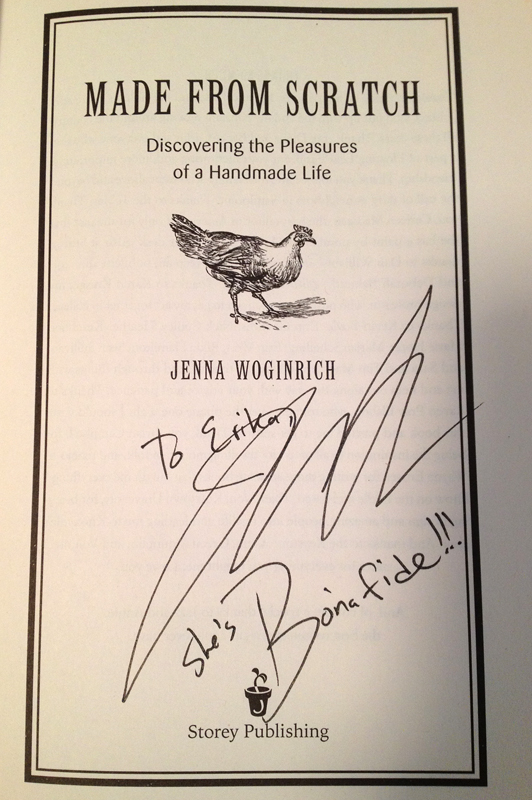
As hoped, I got to talk with her for a few minutes and tell her a bit about my farm. I bought all her books and she signed them for me before she had to run out to give her keynote, which highlighted the importance of community to any farming endeavor. Certainly true, especially for single farmers such as Jenna and myself!

And then day two of the fair came to a close and I retired to dinner and a wonderful hotel sleep. I always sleep well in hotels—I think the secret lies in blackout curtains!
Stay tuned for day three, in which we learn about heritage goats and “make friends with our kombucha!”
August 22nd, 2012 §
Isn’t this scene the start of some fairytale? Or paperback romance about a wayfaring stranger tempted off the trail by the scent of home-baked pie?

I’ll let you know how it turns out!
(the stranger, not the pie, which I already know will be good!)















































